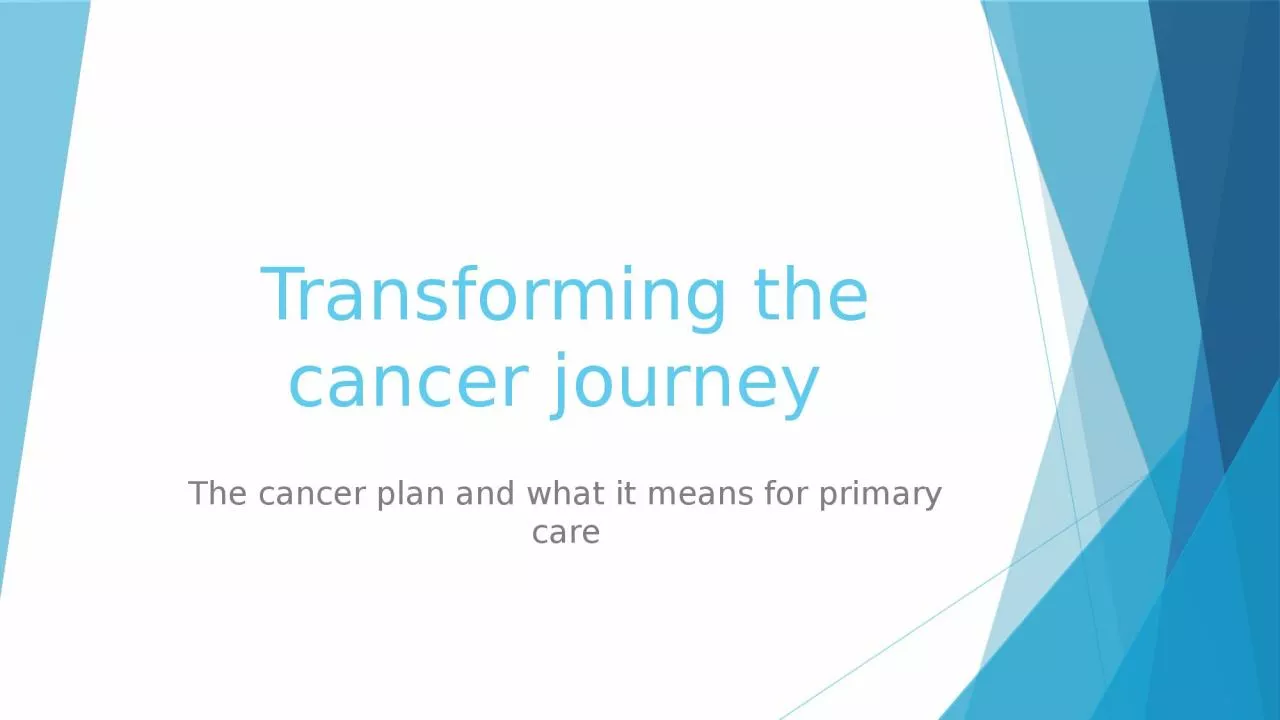

The cancer plan and what it means for primary care Why do we need a plan Performance Why do we need a plan Demography Ageing population 47 can expect to get a cancer Earlier diagnosisbetter treatment half will survive at least 10 years ID: 1040917
Download Presentation The PPT/PDF document "Transforming the cancer journey" is the property of its rightful owner. Permission is granted to download and print the materials on this web site for personal, non-commercial use only, and to display it on your personal computer provided you do not modify the materials and that you retain all copyright notices contained in the materials. By downloading content from our website, you accept the terms of this agreement.
1. Transforming the cancer journey The cancer plan and what it means for primary care
2. Why do we need a plan? Performance
3. Why do we need a plan? DemographyAgeing population -47% can expect to get a cancerEarlier diagnosis/better treatment half will survive at least 10 years.By 2030 4 million patients living with and beyond cancerSuccess story… but1/3 have long term consequences of diagnosis/treatment
4. ‘World class outcomes’
5. Cancer transformation planNational Board- strategic- originator of planCancer Alliances (regional) (cf previous networks)Seeking funding and will choose projects and monitor (via diagnostic and other boards)󠇄 Cancer Steering group CCG, secondary, primary careWorking group- focussing on role of primary care and resources
6. PrioritiesPREVENTION, SCREENING,EARLY DIAGNOSIS Recovery PackageRe stratification of follow up breast/bowel/prostateALSO patient experience metricsNotion that money will be saved by transformation to further improve services
7. Early DiagnosisPrimary care to become more proactive inPromotion of healthier lifestyle as primary prevention.Awareness of screening uptake and promotion of national programmesSymptom awareness campaignsNICE guidance and the 2 week waitReducing late presentation ? Direct access to diagnostics Management of vague symptoms4 weeks to treatment target by 2020
8. How can we help?Resource packs distributed to practices in South and Central Birmingham and SolihullMacmillan/CRUK practice visits ( part of this year’s incentive scheme in Solihull) Review practice cancer profile on PHE Fingertips Look at easy, sustainable ways to promote preventive strategies and screening programmes Look at resources to support early diagnosis of cancer Raise awareness of developments in cancer rehabilitation
9. 4 cancers in 10 are preventableReduce alcohol Keep a healthy weightEat fruit and veg Stop smoking High fibre diet Sunscreen Exercise Reduce intake processed meat Healthy lifestyle message- but public not so aware of cancer prevention, Same factors aid recovery!
10. ScreeningBowel, breast, cervix (and soon some targeted screening?)Variations in uptake relating to deprivation ethnicity learning difficulty first language mental illnessOn the horizon- bowelscope/fit test
11. Earlier diagnosisSymptom awareness ( publicity campaigns)Willingness to presentAccess to appointmentContinuity2ww criteriaAtypical/vague sx and repeated consultation
12. Late Diagnosis: CRUK study 278 lung or colorectal cancers (emergency presentation)CRUK study Emergency presentation of 278 lung colorectal cancerMost at risk: elderly, carers, ‘philosophical’ (? Mental illness, learning difficulty)Beware vague sx, persistent new sx, atypical sx, symptom noise.Care with safety netting, communication investigations (false reassurance/lost reports)
13. The Recovery PackageBegins at diagnosisHolisticIndividual Care Plan, patient centredOperates across hospital and primary careApproaches cancer as a long-term condition, like diabetesAims to enable patient to live a full life with and beyond cancer
14. The Cancer Journey (present model)DiagnosisTreatmentDischarge..Then? cancer care review in primary care
15. At discharge from treatment...Patients report initial elation... Then, oftenAnxiety/ fear (especially of recurrence)Fatigue, low moodIsolation and a sense of abandonmentDifficulty getting back to ‘normal’Problems with relationships and workNeed for information
16. The Recovery PackageEarlier diagnosis & referral Secondary Care: At diagnosis: a holistic assessment/care planTreatment Dischargeholistic needs assessment/summary care plan/health and well being eventMore care shared with primary care
17. Holistic Needs AssessmentPatient-led Leads to individual care planAim is to assess at diagnosis and discharge and between if neededMainly hospital based so far. Use of ipads to collect dataFeedback- focuses consultations without opening ‘can of worms’
18. Which Clinician?In hospital, multidisciplinary. (and ipads!)GPs can quickly learn process.... butMac trained nurses are starting to carry out cancer care reviews in primary care using the holistic needs assessment/care planThis format is also suitable for annual review required on the stable prostate pathway.
19. Restratified follow upFor breast, bowel, prostate cancersEarlier discharge of low risk patientsRehabilitation, then….‘supported self management’ as with other long term illnesses.Careful pathway redesign (safety-netting)Resistance to change?
20. TransformationResourcesWillingness to change Willingness to work across existing boundariesBetter communication/sharing of careSkill mix…..huge potential gain for patients!
21. Family and Friends...What journey would we choose for them?